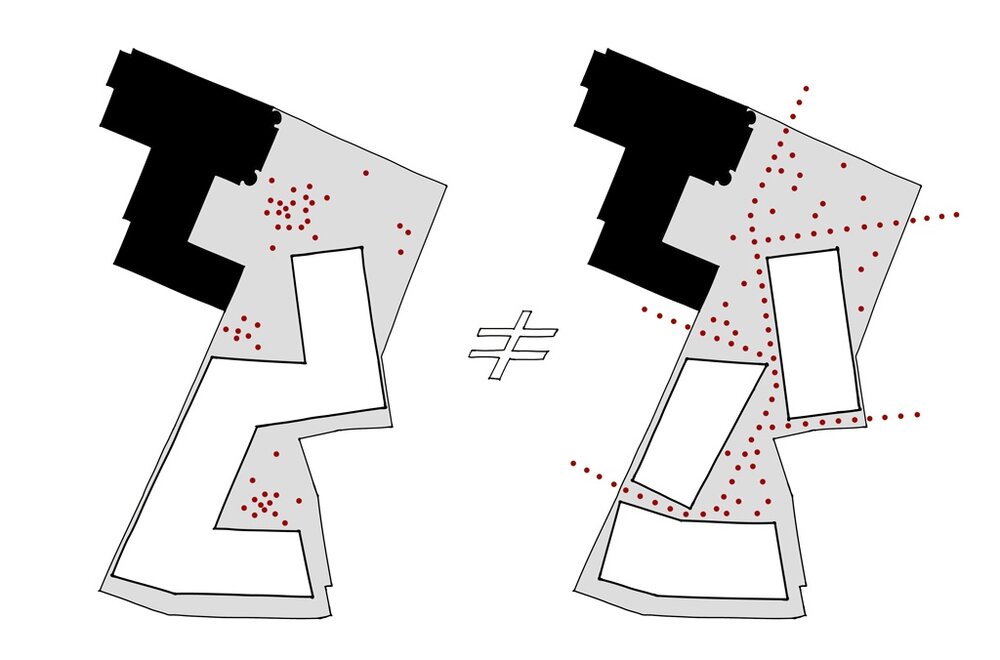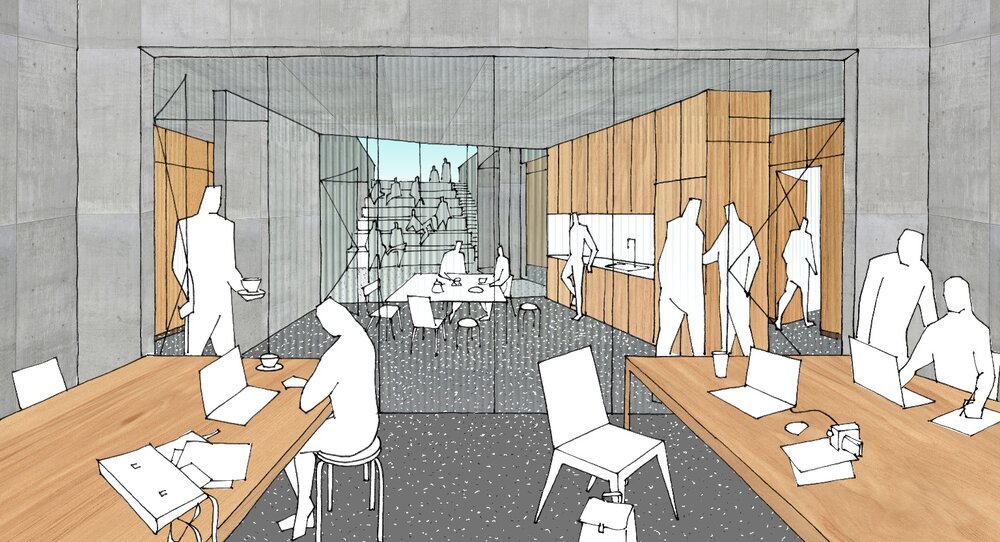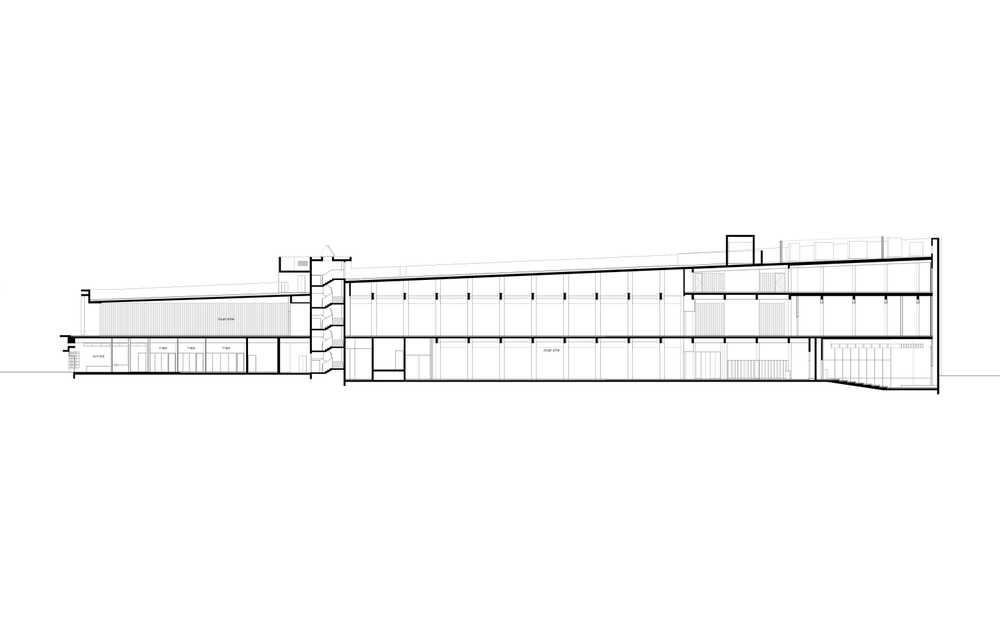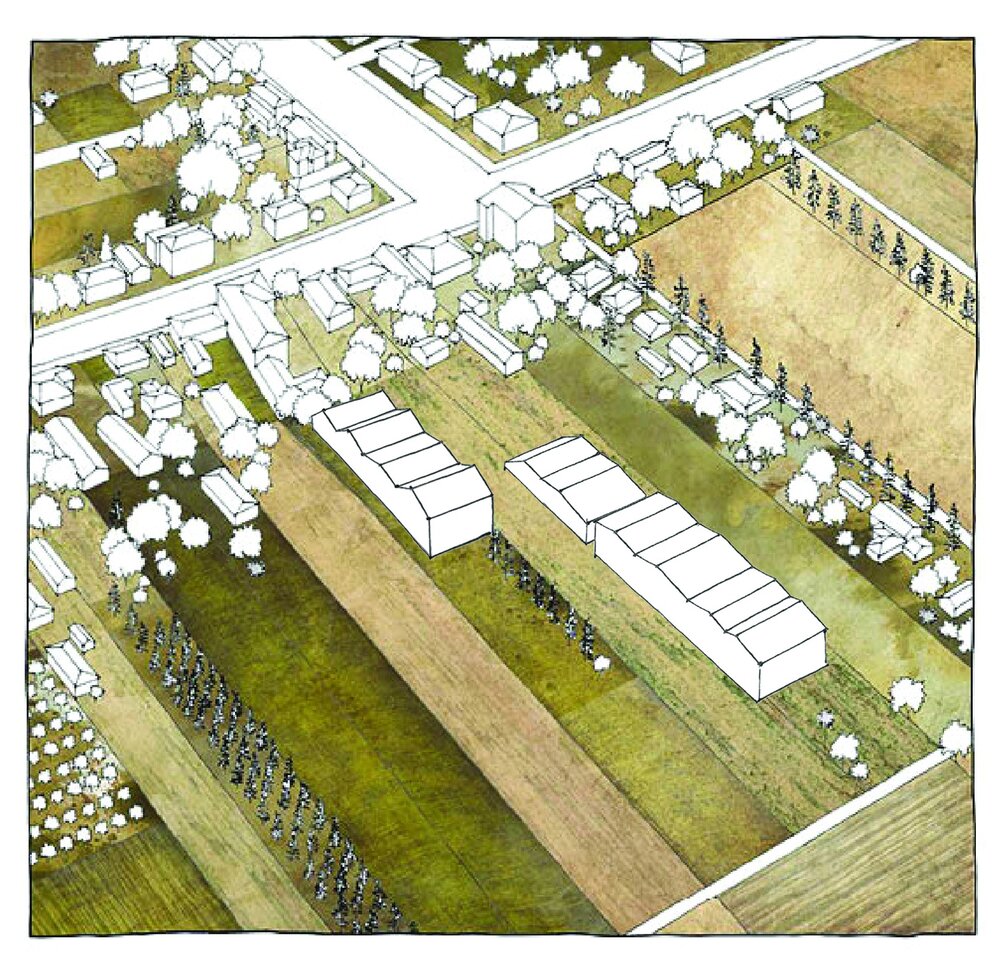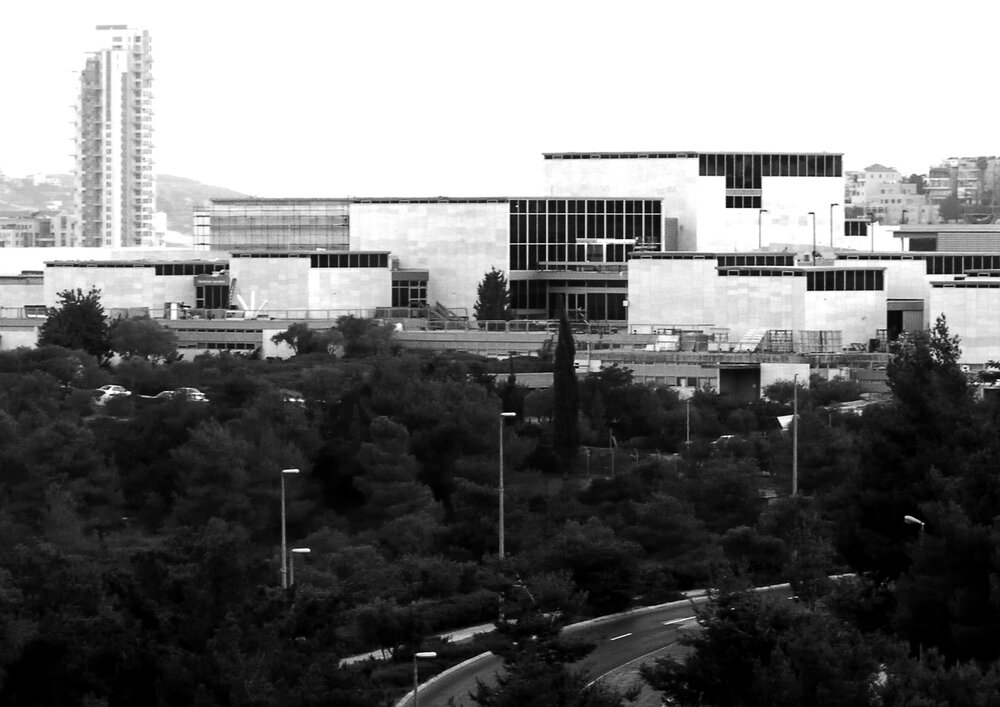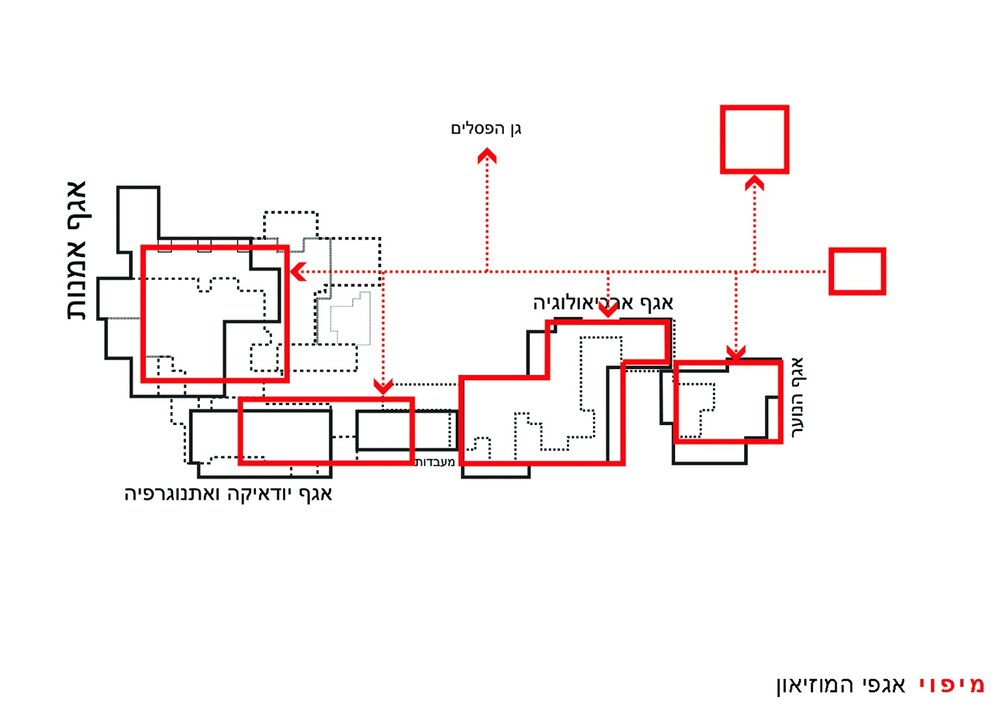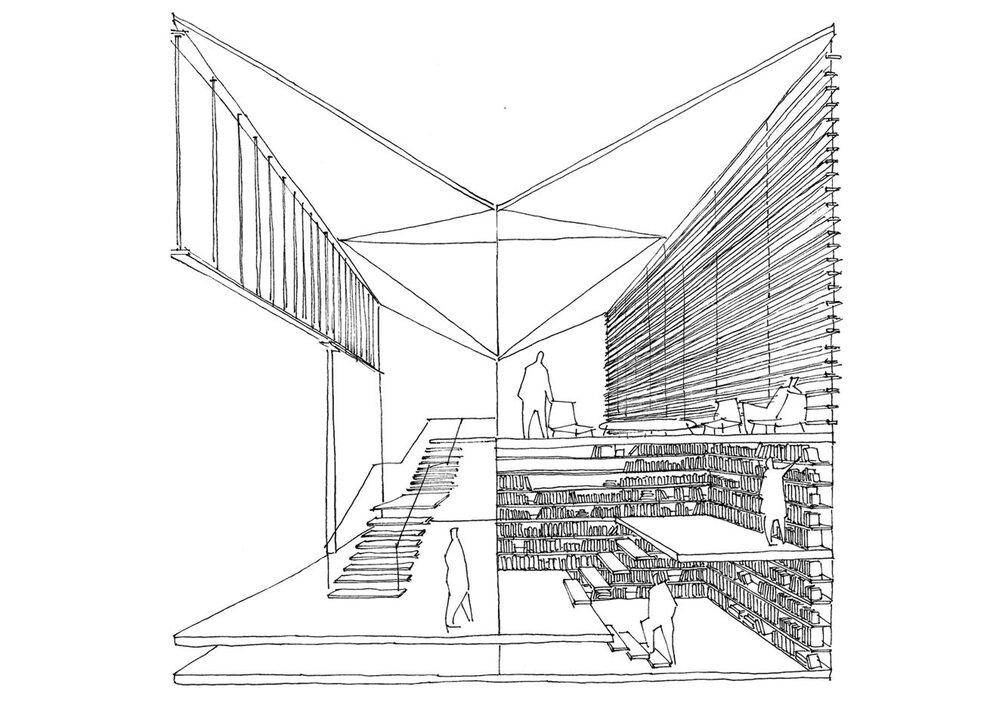Jerusalem Art Campus
Location: Jerusalem
Year: 2016-2021
Area: 10,000 sqm. + 15,000 sqm. underground parking (450 spaces)
Status: Under construction
Program: 4 higher education performing arts schools, approx. 650 students
Client: Jerusalem Economy Ltd.
Project Architect: Talma Weitzner
Team: Ido Levy, Avinoam Sharon, Adi Samet, Alon Sarig, Artyom Berlinsky, Roy Finkelman, Quentin Derollez
CD: Tami Yaniv Architecture
Landscape Architect: Sack and Reicher Architects
Project Management: Yoni Goldstein - Ehud Tayar ltd.
Structural Engineering: J. Kahan & Partners.
Project Description
The new Performing Arts Education Center is located at Jerusalem’s Menorah square and composed of 3 buildings and a sequence of plazas and internal courtyards. The project’s layout of an open campus relates to the city’s typical massing and introverted public spaces. It connects Jerusalem’s downtown with the old residential neighbourhood of Nahlaot and allows a continuous pedestrian flow through its courtyards. The stone facings of the buildings are designed as thin curtain walls applied on concrete bodies, creating a double skin and leaving air space between the layers for fresh air circulation and insulation. Each building has a slightly different texture, articulation and fenestration.
The Performing Arts Education Center is a joint project of the Jerusalem Municipality, the Jerusalem Development Authority and the Jerusalem Foundation. It will be home to four leading performing arts schools: The Sam Spiegel Film & Television School, The School of Visual Theater, The Nissan Nativ Acting Studio and The Center for Middle Eastern Classical Music.
The Performing Arts Center was described by the city’s Mayor as a “transformative project set to invigorate Jerusalem's city center and enrich the lives of the local young adult community.
Ramat Gan Museum of Israeli Art
Location: Ramat Gan
Year: 2015-2020
Area: 3,000 sqm
Status: Built
Client: Ramat-Gan Municipality
Team: Avinoam Sharon, Ido Levi, Alon Sarig, Talma Weitzner
Project Management: Davelman-Perzlina Projects and Buildings Management
Structural Engineering: Dan Shaham
Project Description
The Museum of Israeli art in Ramat-Gan resides in a building listed for preservation, designed by an unknown architect in 1936 for industrial use. In 1987 it became the Museum of Israeli Art and as such it revived the idea to establish at the nearby Veterans Neighborhood an artists community. Our proposal was based on the following principles:
Restoring and reactivating the artists’ studios in the area in order to revive the initial idea of a cultural compound with a museum and a sculpture garden integrated.
Defining and amplifying the unique morphology of the buildings' original acute triangle plan, (including the removal of additions accumulated during the years).
Preservation of the original building, its envelope, its spinal free-standing columns and beams system, its openings and iron frames, as well as a lookout post attached to the north elevation of the building (probably in the 1940’s).
Reinstating the building’s flat roof as a fifth façade; The roof will be utilized for events and exterior exhibition events.
Location of the main entrance to the museum on the north facade, at the seam between the historical building and the new extension.
Integrating additional programs such as: auditorium, youth wing, storage space, and cafe (located at the “nose” of the building.
Use of industrial elements for the new envelope of the building, such as vertical pre-cast concrete elements and structural-glass, as a gesture to the building's origins as a modernist factory.
Haviv School
Location: Rishon LeZion
Year: 2015-2019
Area: 3,000 sqm
Site area: 13,000 sqm
Number of Classrooms: 18
Status: Built
Client: Rishon Lezion Municipality
Team: Adi Samet, Ido Levi, Quentin Dellerze
Collaboration: Dan Hasson
Landscape Architect: Inside-Outside, Amsterdam; Moria-Sekely, Tel Aviv
Project Management: Eli Gotlib
Structural Engineering: Rokach & Ashkenazi
Olympic Swimming Pool, Jerusalem
Location: Hebrew University Campus, Give’at Ram, Jerusalem
Client: Jerusalem Municipality
Area: 14,000 sqm
Team: Meira Kowalsky, Alon Sarig, Talma Weitzner
Year: 2018
Status: Not built
Bait La’Ivrit
Location: Rishon LeZion
Year: 2015-2017
Area: 6,000 sqm
Site area: 13,000 sqm
Status: Unbuilt
Client: Rishon Lezion Municipality
Team: Adi Samet, Alon Sarig,
Collaboration: Dan Hasson
Landscape Architect: Inside-Outside, Amsterdam; Moria-Sekely, Tel Aviv
Project Description:
The International Center For the Hebrew Language in Rishon leZion is situated on the grounds of Haviv elementary school - the first school to teach modern Hebrew - established in 1882.
The center will operate in coordination with the school, which operates till this day in the core of the historical city of Rishon le Zion. The school's original building will be conserved and used as a museological space for the school and the Hebrew language. The adjacent historical 'Medalya' house will be conserved as an integral part of the site and will host a coffee house.
The public complex, enfolding The International Center For the Hebrew Language; which will host manifold audiences for experiential learning, Enrichment activities, meetings and conferences regarding the Hebrew language.
The open spaces of the project are designed as a continuous urban promenade intertwined with the interior spaces at the ground floor of the Hebrew Center. The entire site is encompassed on its perimeter by a green pergola, providing outdoor classrooms and shaded play-areas for the school, hangouts for the Hebrew Center and a soft buffer from the adjacent neighborhood.
Indian Jewish Heritage Center
Location: Moshav Nevatim
Client: The Cochin Jewish Heritage Center
Area: 5,000 sqm
Team: Avinoam Sharon, Alon Sarig
Year: 2017-present
Status: Design Development
Ben-Gurion Center
Location: Ben-Gurion blvd. Tel-Aviv
Client: Ben -Gurion Foundation
Area: 1,500 sqm
Team: Avinoam Sharon, Talma Weitzner, Alon Sarig
Year: 2016
Status: In progress
Project Description
The Ben Gurion Center project is an addition of a new building in the backyard of the historical Ben Gurion House. Currently, the Ben Gurion House is a museum and visitors’ heritage center, located in Ben Gurion Boulevard, at the heart of Tel Aviv. It was David and Pola Ben Gurion’s residence from 1931 to 1973. As such, it offers a view to the formative decades of the State of Israel through the domestic environment and its first Prime Minister.
The new back building designed for the Ben Gurion Center will double its floor area and add a wider and more diversified perspective on the figure of Ben Gurion and his historical, political and cultural context. The design scheme therefore does not rely on common articulation of designated spaces - archive, library, exhibition hall, seminar room, auditorium, etc. - but rather on multi-purpose spaces adaptable to a variety of different activities and technologies of representation.
The volume of the new building exceeds the roofline of the surrounding buildings, built initially in the 1930s and partially reconstructed in the 1960s, in order to mark it as a public edifice tucked-in the fabric of a residential neighborhood. Its architectural expression intends to convey both a certain administrative monumentality and civic notions of transparency and accessibility. The sharp slope of the roof lowers to new volume towards the historical building and evens the heights of old and new at the point they face each. A hovering bridge connects the two and allows a flow of circulation from Ben Gurion’s library to contemporary spaces of retrospection.
The project’s overall layout of a front, preserved building, and a new back building, creates a small urban campus with an internal “pocket garden” (in contradistinction to a backyard) and invites neighbors and visitors to traverse it and explore the interior and exterior spaces of the renewed Center.
Holocaust Museum of Greece, Thessaloniki
Location: Thessaloniki, Greece
Year: 2015
Area: 8,000 sqm.
Status: In Progress
Client: The Jewish Community of Thessaloniki
Team : Avinoam Sharon, Alon Sarig, Roy Finkelman
Collaboration: Heide & Von Beckerath Architekten Berlin, Makridis Associates, Thessaloniki
Project Description
Thessaloniki’s Jewish community, the oldest in Europe, was present in the city for 2,000 years and was the largest ethnic community of the city between 1492 and 1912.
The fire of 1917 destroyed many of the Jewish buildings of Thessaloniki and the extermination of the Jewish community during the German occupation of World War II erased much of the city’s Jewish fabric.
By offering Thessaloniki a new public monument, the proposed Holocaust Memorial & Human Rights Educational Center seeks to commemorate the devastating fate of the Jewish community, but also to recount its cultural history and rejuvenation after the war, and to host an open forum for multi-cultural education and forward-looking dialogs between various identity groups.
The project consists of an octagonal tower, a low ring-shaped building and a public plaza. The 32 meter high energy-efficient tower is a museum, an archive and a cultural center.
Lustiger Garden
Location: Abu Gosh
Year: 2012
Area: 6,000 sqm
Status: Built
Client: Abu Gosh monastery
Team: Quentin Dellerze
Project Management & Construction : Asaf Liptman
Project Description:
The Cardinal Lustiger Memorial at the Monastery of Abu Gosh is designed to be a gathering place with an atmosphere of contemplation in a picturesque setting. The design includes a small amphitheater built of local stone, resembling the existing stone terraces in the garden; an ecological reflection pool as a focal point for meditation and contemplation; integrated paved areas with the landscaped garden; and ceramic plates made by the monks of the Abu Gosh monastery with texts by Cardinal Lustiger.
The Israel Museum - Archaeology Wing
Year: 2005 -2010
Area: 3,000 sqm
Client: The Israel Museum
Status: Built
Original architect: Al Mansfeld and Dora Gad
Exhibition Design: Pentagram, London
Team: Carmit Hernik-Saar, Hila Rak-Broides, Ruth Kedar
Project Management: Ira Davelman, Am-Gar Project Management Ltd.
Structural Engineering: Yossi Gordon
Project Description
The Archaeology Wing project was a delicate preservation project which entailed the restoration of both the external stone envelopes and the internal exposed concrete walls, ceilings and columns. Our work on this wing included reorganization of the circulation into a longer and a shorter narrative path (including the addition of new modules to enable a loop movement); re-opening of windows to allow views to the outside and (diffused) natural light; stabilizing the central hypar-columns (“mushrooms”) and the cantilever roofs; re-routing the drainage system; inserting a new electrical and HVAC systems; and exposing the original texture of the brutalist walls and ceilings. EKA has also done the working drawings for the interior layout and display cabinets designed by Pentagram.
The Israel Museum
Year: 2003-2010
Site area: 80,000 sqm
Pre-existing built area: 50,000 sqm
New built area: 6,000 sqm
Construction budget: 100,000,000 USD
Client: The Israel Museum
Status: Built
Original architect: Al Mansfeld and Dora Gad
Collaboration: James Carpenter Design Associates
CD: A. Lerman Architects
Team: Carmit Harnik Saar, Ruth Kedar, Rinat Shteinlauf, Hila Rak-Broides, Dan Koniac, Charlotte Mottahedeh.
Project Management: Nizan-Inbar Project Management Ltd.
Structural Engineering: J. Kahan & Partners.
Project Description
The renewal of the Israel Museum in Jerusalem is a project of renovation, reorganization and expansion of the national museum designed by architects Al Mansfeld and Dora Gad in a 1959 competition and opened in 1965. The original museum was conceived as an open-ended accumulative system with inbuilt possibilities to evolve and mutate within a fixed grid and according to modular increments.
Indeed, the prospect of unrelenting growth has proved justified and the museum has multiplied its floor area ten times within about 40 years without losing its mathematical composition.
The incredible growth of the museum has brought it to the brink of an organizational and operational collapse. While the initial design system had been successful in maintaining the appearance of formal coherence, internally the colossal structure became unsustainable, out of scale and at odds with its own program.
We were commissioned to draft a new master plan for the museum in order to resolve the internal organizational problems, reorganize the entrance and circulation system and speculate on potential areas for further expansion.
Our proposal was based on a subtle strategic intervention that consolidated the existing cellular structures and added missing links that would allow the museum complex to function again. The intervention included a new entrance and ticket pavilion with a generous forecourt; an inserted passage leading to a new core element from which all internal galleries and departments of the Museum are accessed; reorganization of all galleries for better accessibility, orientation and visibility; and finally preservation work which included rehabilitation of external stone facing and internal exposed concrete surfaces and restoration of natural lighting in the exhibition spaces.
All stages, from conceptual master plan to internal fit out, have been carried out on schedule and on budget. The Israel Museum re-opened to the public on July 2010.
With the conclusion of the project, EKA is proud to put forward two unusual achievements: First, albeit the massive structural, spatial and material transformations, the museum has kept its original sense of place, set of proportions and spatial flow. Second, while adding less than 10% to the existing envelope of the museum, we managed to double its exhibition area by considerably improving its internal performance.
Beit Ha'ir Museum
Location: Bialik Square, Tel Aviv
Year: 2006 - 2009
Area: 1,600 sqm
Status: Built
Client: Tel Aviv-Jaffa Foundation
Original architect: Moshe Cherner
Team: Yonathan Cohen, Ariel Noyman, Carmit Hernik-Saar
Interior Design: in collaboration with Dan Hasson
Project management: Am-Gar Project Management Ltd.
Structural Engineer: Rotbart - Nissim Structural Eng. Ltd.
Project Description:
The City museum of Tel Aviv, locally called Beit Ha’ir, was opened to the public in December 2009 in honor of the city’s centennial. The building housed the city hall between the years 1926-1965 and then the city museum until 2001. The aim of the project was to restore the historical building that was the first civic center of the city. Together with Bialik Square, the building functioned as an urban focal point for ceremonies, celebrations, demonstrations and parades. The front facade occasionally served as a balcony for performances and historical events.
The aim was not only to restore the historical appearance of the building but mainly to endow it with another performative cycle and re-structure it as a relevant civic center.
Of-Ar Civic Center
Location: Of-Ar, Ofakim
Area: 20,000 sqm
Year: 2009
Collaboration: Joseph Dadoune, Yitzhak Krispel, Dan Hasson
Status: Unrealized
Project Description:
The Of-Ar project is a pocket utopia, a communal space, a cultural Hothouse and an accelerator for local businesses aspiring to avoid common typologies of public buildings and to offer instead a mixed platform that may support actual communal, cultural and entrepreneurial activism. As such, the project aims to become a catalyst for urban renewal in the city of Ofakim and an exemplary showcase of its social and cultural resourcefulness.
The project is based on three existing venues of activism in Ofakim: The first, is the venue of social empowerment and support for local business initiatives, led by the local activist Itzik Krispel. The second is the artistic and cultural activity in Ofakim, led by the artist Josef Dadoun. Third is the architectural and urban research and design work, examining the potential for re-purposing and re-use of abandoned industrial structures in New Towns erected during the 1950s and 60’s in the southern periphery of the country, led by architect Zvi Efrat.
The project suggests to re-use the skeleton of the abandoned textile factory of Of-Ar (opened in 1961, closed 1986). The intention is not to renovate or restore the building, but rather to keep most of it as it is: open, exposed, with no roof, and to turn it into a public botanical garden for gatherings and temporary events. Several autonomous modular pavilions are inserted to the garden-space to allow for Multi-functional services and activities such as shops, a business incubator, and an employment agency together with artist studios, exhibition spaces, and a library.
The tension between the decaying structure and the designed garden, between old industry and new ecology, will characterize other “splits” on site: between labor and leisure, research and art, itinerary and spontaneity, NGO’s and local business.
Ghetto Fighters’ House Museum
Location: Kibbutz Lohamei Ha’Ghettaot
Year: 2003 - 2006
New addition: 1,500 sqm
Status: Built
Client: Ghetto Fighters' House Museum
Original architect: Samuel Bikeles
Team: Dror Aviram, Keren Avni, Rinat Calev
Project Management: Barnea Engineering and Building Ltd.
Structural Engineering: Kidan Structural Engineering Ltd.
Competition: Winning Entry
Project Description:
The Museum was built in the 50’s by the founders of Kibbutz Lohamei Ha’gettaot, whose entire population were survivors of the holocaust. The members wanted to establish a place for ongoing testimony and education concerning the holocaust and the rebellion of the Warsaw Ghetto.
GFH was built as an active repository of first-hand testimonies and personal biographies, asking to memorize history as a continuous present, and to emphasize the relation between individual testimonies and the collective experience. The big narrative offered by other museums is here toned down into direct, subjective, spoken, intimate and unmediated meeting of the speakers and the listeners of the testimony. For us, the architectural task was clear, but rather unusual: how to maintain the existing building and to keep it as a reverberation chamber of live testimonies, when the transmitters themselves are no longer there to meet the visitors and guide them through the building. In other words, the conceptual challenge was not to reproduce or simulate, but rather to re-enact the original situation of GFH.












